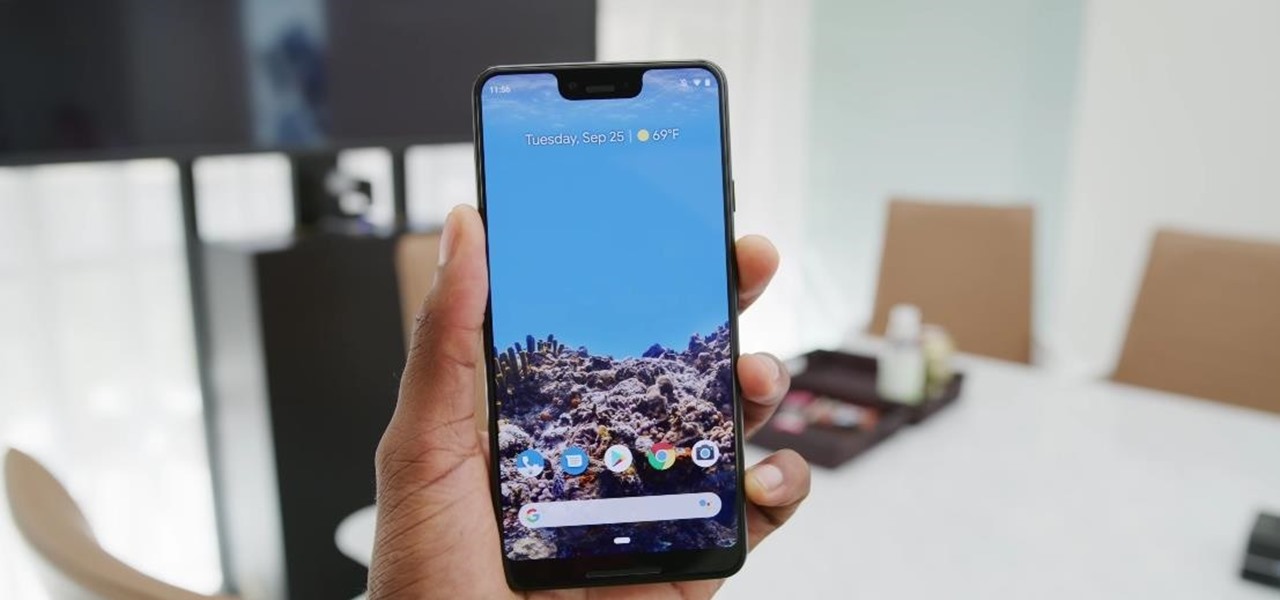The "controversial" Pixel. No phone in the history of Google's Pixel lineup deserves this title more than the Pixel 3 XL. For some (including myself), the design is a welcome change that embodies the modern design of 2018 flagship phones. For others, it has an ugly huge display notch that destroys symmetry.
As you make your way around the internet checking out hands-on impressions and reviews of the Pixel 3 XL, the primary focus of most users will be the display notch. Is it too big or is it overblown? However, when you look past (if you can) the display notch, you will see a solid upgrade from last year with an even better camera, larger display, and even better battery life.
Jump to a section: Important Dates | Storage Capacity | Price for Everything | Body | Basics | Display | Performance | Battery | Front Camera | Rear Camera | Audio | Sensors | Connectivity | Security | Software | Box Includes
Important Dates
The new Google Pixel 3 XL was announced on October 9, 2018, at Google's Made by Google Launch Event. The Pixel 3 XL will be available for preorders starting on October 9th from Google and Verizon Wireless, its exclusive US partner. Pixel 3 XL (alongside Pixel 3) will ship later on October 18.
- Release date: October 18, 2018
- Preorder date: October 9, 2018
- Announced: October 9, 2018
Storage Capacity
Similar to last year, the Pixel 3 XL will come in two storage variants: 64 GB and 128 GB. Like its predecessor, it doesn't have expandable storage. However, it will provide users with unlimited cloud storage of all photos and videos when stored on Google Photos.
- Storage available: 64 GB or 128 GB
- Expandable storage: no
Price for Everything
The new Pixel 3 XL's pricing starts at $899 for the 64 GB model and increase to $999 for the 128 GB version. For whatever reason, Verizon is charging an additional $30 on the Pixel 3 XL. Therefore, the 64 GB version starts at $929.99 and the 128 GB version is $1029.99.
- Price: $899 (64 GB), $999 (256 GB) plus tax. On Verizon Wireless, $929.99 (64 GB) and $1029.99 (128 GB)
Body
Only one major thing has changed from last year when it comes to the body: The rear panel is now 100% glass instead of metal with a glass window at the top. Once again, the Pixel 3 XL will use an aluminum frame with a hybrid coating. It will use Corning Gorilla Glass 5 on the front and the back, with the lower portion of the back having a soft-touch finish. As for colors, there will be three options: Clearly White, Just Black, and Not Pink.
- Frame: Aluminum unibody with hybrid coating
- Corning Gorilla® Glass: 5
- Colors: Clearly White, Just Black, and Not Pink
Basics
Despite the increase in screen size (more on that later), the phone itself is only marginally larger than its predecessor. As for dust and water protection, both devices support the highest rating of IP68. With a rating of six, both devices are basically dust-proof. As for the eight, it means the devices can remain submerged in up to two meters of water for up to 30 minutes.
The Pixel 3 XL will work on all four major carriers. Verizon is the exclusive US carrier and the only one where you can buy the Pixel 3 in store. As for T-Mobile and Sprint, using the GSM-unlocked variant, all you need to do is pop in your SIM card. As for Sprint, using the BYOD program, you can activate the device for use on their network.
- Height: 6.22 inches
- Width: 3.02 inches
- Depth: 0.31 inches
- Weight: 6.49 ounces
- Dust/water resistance: IP68
- Supported carriers: AT&T, Sprint, T-Mobile, Verizon
Display
The Pixel 3 XL's screen increased in size to 6.3 inches, the largest of any phone in the Pixel lineup. Unlike its little brother, it has an aspect ratio of 19:9 largely due to the display notch housing one of the stereo speakers and dual front-facing cameras. It has a higher resolution of 2960 x 1440, which results in its 531 ppi.
The display is OLED. Unlike last year, Google switched to Samsung panels, the Super AMOLED specifically. This might be because of all the issues last year's Pixel 2 XL dealt with when they used the LG POLED, but the results are impressive. Thanks to the switch, the Pixel 3 XL was able to receive the highest mark from DisplayMate at A+, something only two other phones have achieved (the Galaxy Note 9 and iPhone XS Max). It also supports HDR and is certified by UHD Alliance.
- Screen size: 6.3 inches
- Screen resolution: 2960 x 1440
- Pixel density: 523 ppi
- Screen type: OLED
- Notch: yes
- Screen-to-body ratio: 82.8%
- Aspect ratio: 19:9
- DCI-P3 coverage: Currently unknown
- Contrast Ratio: Currently unknown
- Refresh rate: 60 Hz
Performance
Once again, Google has given both of its phones the same internals. Both devices are once again limited to 4 GB of RAM. To no surprise, the SoC of choice is the latest and greatest from Qualcomm, the Snapdragon 845. The 10 nm SoC has eight cores, four Kryo 385 Gold and four Kryo 385 Silver.
The former are custom cores based on the Cortex-A75 spec and run up to 2.8 GHz. The Silver Cores are derived from Cortex-A55, making them more power efficient. These run at a frequency of 1.8 GHz and are used for less power intensive tasks. However, to save on battery, Google opted to underclock both cores to 2.5 GHz and 1.6 GHz, respectively.
The GPU paired with it is the Adreno 630. This is a four-core GPU clocked at 710 MHz which produces 737 GFLOPS. Additionally, the Google-developed Pixel Visual Core is on board to manage the AI processing of the cameras. And Google is including the Titan M Security Module to house cryptographic keys.
- Memory: 4 GB RAM
- Processor: Qualcomm Snapdragon 845
- Chip size: 10 nanometer
- CPU frequency: 2.5 GHz and 1.6 GHz
- CPU cores: 8
- GPU: Adreno 630
- GPU cores: 4
Battery
The battery is actually smaller than last year's Pixel 2 XL at 3,450 mAh. While this combination of a smaller battery and bigger screen would equal lower battery life, the underclocked CPU should help achieve comparable battery life to its predecessor.
It comes as no surprise that the fast charging protocol of choice is USB Power Delivery. Google has been pushing the technology for years, asking OEMs to switch from Qualcomm Quick Charge. With USB PD, not only can the Pixel 3 XL charge to a full day of usage in 30 minutes, but will also remain much cooler in the process. And for the first time, the Pixel 3 and 3 XL will finally support wireless charging. Google announced a new charging pad that offers 10 W of wireless charging power and activates a new menu that turns your Pixel 3 into a mini Google Home Hub.
- Battery: rechargeable lithium-ion
- Capacity: 3,430 mAh
- Charging: USB Power Delivery (USB PD) and Qi Wireless Charging
Front Camera
While Google continues to ignore the multi-camera trend on the rear camera, the front-facing camera is a different story. Google is including dual front-facing cameras, both of which are 8 MP. The big addition is the second sensor, which has a wide-angle lens to capture more of your surroundings. It has an aperture of ƒ/2.2 and a field of view of 97°.
The main lens has a ƒ/1.8 aperture and a standard field of view of 75°. It also has autofocus and face detection.
- Resolution: 8 MP and 8 MP
- Aperture: ƒ/1.8 , ƒ/2.2 (wide-angle)
- Zoom: no
- Flash: screen-based
- Image stabilization: software-based
- RAW support: no
Rear Camera
The Pixel 3 XL continues to hold on to the single rear camera. Unlike phones like the LG V40 and Huawei P20 Pro which went as high as three cameras this year, Google is sticking to its tried and true single AI-enhanced lens. However, even with a single lens, the Pixel 3 XL manages to perform just as well as multiple cameras.
Both the Pixel 3 and 3 XL use the same 12.2 MP lens with a ƒ/1.8 aperture and 1.4µm pixels. However, thanks to Google Visual Core and HDR plus, the Pixel 3 XL is able to capture an abundance of detail and process this detail in a matter of seconds. Pixel 3 XL comes with several new features to improve photography.
Top Shot takes several photos, and using machine learning, the Pixel 3 XL will recommend the best photo from the list where everyone was smiling and eyes were open. Night Sight uses machine learning to choose the the right colors in low light settings for well-lit photos without the flash.
- Resolution: 12 MP
- Aperture: ƒ/1.8
- Zoom: Digital, AI-enhanced
- Flash: Multi LED
- Image stabilization: optical and electronic
- RAW support: yes
- Lens cover: sapphire crystal
- Object detection: bodies, faces
As for video recording, you can shoot videos in either 720p, 1080p, or 4K resolution. Similar to last year, you can record up to 240 fps when using 720p. 4K resolution is limited to 30 fps.
- Resolution: 720p, 1080p, and 4K
- Max frame rate: 60 fps for 720p, 60 fps for 1080p, 30 fps for 4K
- Slow motion: yes, 1080p at 120 or 720p at 240 fps
- Photos: 8 MP stills while recording 4K
- Zoom: 1x optical, 6x digital
- Flash: Yes
- Image stabilization: optical and electronic
- Lens cover: sapphire crystal
- Audio: stereo sound
Audio
Once again, Google has not included the 3.5 mm headphone jack with the device. However, Google (for the first time) is including a pair of USB-C earbuds to compensate. Additionally, with Android 9.0 Pie on board (more on that later), the Pixel 3 XL supports many Hi-Fi audio codecs, including Sony LDAC and Qualcomm aptX and aptX HD.
Additionally, the front-facing speakers are making a return. These are stereo speakers, each housing on speaker grill in the chin, and one either in the forehead (Pixel 3) or the display notch (Pixel 3 XL). They are 40% louder than last year's Pixel 2 XL.
- 3.5 mm headphone jack: no
- Stereo speakers: yes, front-facing
- Mics: three total
Sensors
You will find all the standard sensors in the Pixel 3 XL.
The accelerometer senses the movement and tilt of your device. This sensor is often used by Google Maps to detect your movement as you navigate toward your destination. It is also helpful for games which use the tilting of the phone for controls.
The built-in proximity sensor detects when objects are close to the screen, turning off the display when you place your ear to the speaker. The Hall effect sensor is used to detect flip covers to activate a menu to display once placed in the accessory.
The magnetometer detects the Earth's magnetic field along the X, Y, and Z axes. It can be used for a basic compass app or provide elevation data. The barometer measures air pressure and the ambient light sensor detects the surrounding light for automatic screen brightness.
The Pixel 3 also once again has Active Edge, pressure sensitive sides that can be squeezed to activate an app. As with its predecessor, this will activate Google Assistant.
- Sensors: Active Edge, barometer, accelerometer, gyroscope, proximity sensor, magnetometer, ambient light sensor, Hall effect sensor
Connectivity
Pixel 3 XL includes the latest version of Bluetooth, Bluetooth 5. For connectivity, the GSM unlocked version has a single Nano SIM slot. However, depending on the market, there is also support for eSIM. As for Wi-Fi, the Pixel 3 XL supports up to 802.11ac, one of the fastest version available.
- Wi-Fi: 802.11ac
- Bluetooth: 5 + LE
- NFC: yes
- Cellular: Nano SIM, Supports up to CAT 16, 4 x4 MIMO, 256-QAM
- Port: USB-C
There are three variants of the Pixel 3 XL, one for Verizon, a GSM Unlocked, and a Project Fi model.
- FDD-LTE bands 1, 2, 3, 4, 5, 7, 8, 12, 13, 17, 18, 19, 20, 25, 26, 28, 29, 32, 66, 71
- CDMA EV-DO Rev. A BC0, BC1, BC10
- GSM/EDGE (850, 900, 1800, 1900 MHz)
Security
When it comes to biometrics, Google is once again sticking with the rear-mounted fingerprint scanner. Many Android users prefer this form of biometrics and in this placement. The fingerprint scanner can be used to unlock apps, make payments, and more. And thanks to Android 9.0 Pie, the fingerprint prompt is uniform so that all apps requesting your fingerprint look the same.
Besides the fingerprint scanner, Google is also introducing the Titan security module. This security chip was built specifically for the Pixel 3 lineup and helps secure your password and the operating systems from tampering.
- Security: Fingerprint scanner (rear-mounted)
Software
For years, the Pixel/Nexus line has always introduced the world to the newest version of Android, and this year is no different. Aside from Pixel phones, only the OnePlus 6 has modern internals and runs the latest version of Android 9.0 Pie. There are a number of changes that come with Pie which you can check out with the link below.
- Software: Android 9.0 Pie
Box Includes
If after reading the specs list you are still interested in the Pixel 3 and 3 XL, here is what is included in the box.
- USB Type-C 18W power adaptor
- USB-C to USB-C cable
- SIM tool
- Pixel USB-C earbuds
- 3.5mm to USB-C headphone adapter
- Quick Switch Adapter
- Quick Start Guide
Just updated your iPhone? You'll find new features for Podcasts, News, Books, and TV, as well as important security improvements and fresh wallpapers. Find out what's new and changed on your iPhone with the iOS 17.5 update.



Be the First to Comment
Share Your Thoughts